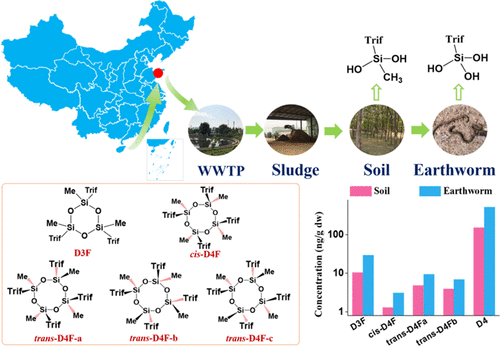当前位置:
X-MOL 学术
›
Environ. Sci. Technol.
›
论文详情
Our official English website, www.x-mol.net, welcomes your feedback! (Note: you will need to create a separate account there.)
Distribution and Elimination of Trifluoropropylmethylsiloxane Oligomers in Both Biosolid-Amended Soils and Earthworms
Environmental Science & Technology ( IF 11.4 ) Pub Date : 2020-12-24 , DOI: 10.1021/acs.est.0c05443 Liqin Zhi 1, 2 , Hongyu Sun 3 , Lin Xu 1 , Yaqi Cai 1, 4, 5
Environmental Science & Technology ( IF 11.4 ) Pub Date : 2020-12-24 , DOI: 10.1021/acs.est.0c05443 Liqin Zhi 1, 2 , Hongyu Sun 3 , Lin Xu 1 , Yaqi Cai 1, 4, 5
Affiliation

|
During a primary screening in 2015 and 2016, tris(trifluoropropyl)trimethylcyclotrisiloxane (D3F) and cis-/trans-tetrakis(trifluoropropyl)tetramethylcyclotetrasiloxane isomers (cis-D4F, trans-D4Fa,b,c) were detected in 12 biosolid-amended soils from Laixi and Shijiazhuang Cities of China, with mean concentrations being 10.3 ng/g dry weight (dw) and 2.7 ng/g dw for D3F and D4F, respectively. Subsequently, one further systematical survey found that although repeatedly amended by biosolids containing trifluoropropylmethylsiloxanes (4.2–724 ng/g dw), these compounds had no increasing trend in biosolid-amended soils (n = 100) collected from Laixi City at five sampling events from February 2017 to June 2019. Simulated experiments indicated that hydrolysis half-lives (1.8–28.0 days) of trifluoropropylmethylsiloxanes in soils were 3.0–18.3 times shorter than volatilization half-lives (7.4–362 days). Compared with those of octamethylcyclotetrasiloxane (D4), the hydrolysis rates of D4F isomers were faster in soils with total organic carbon (TOC) ≤80 mg/g but lower in soils with TOC ≥ 150 mg/g. In earthworm bodies, trifluoropropylmethylsiloxanes had 1.03–1.5 times lower biota-soil accumulation factors (1.3–3.2) but 1.4–3.0 times longer half-lives (2.6–5.7 days) than D4. The stronger persistence of fluorinated-siloxane than the corresponding dimethylsiloxane in both soils (at high TOC levels) and earthworms indicated that environmental risks of these compounds deserve further investigation.
更新日期:2021-01-19


























 京公网安备 11010802027423号
京公网安备 11010802027423号